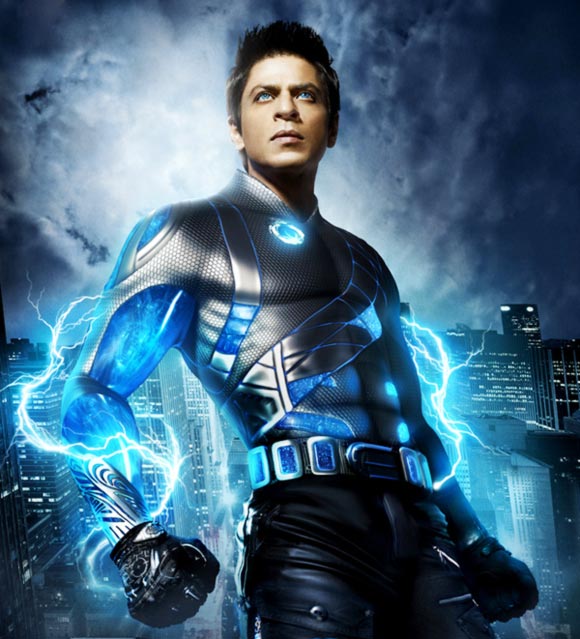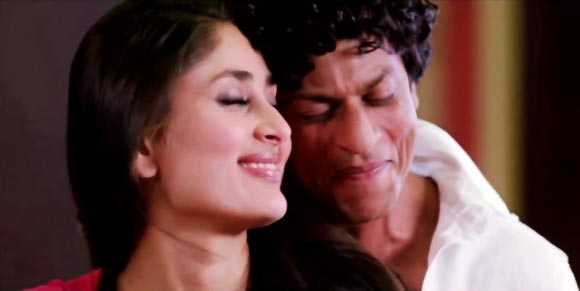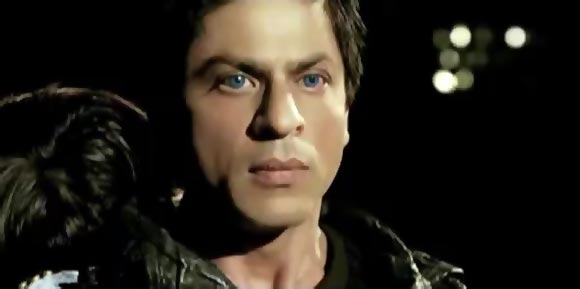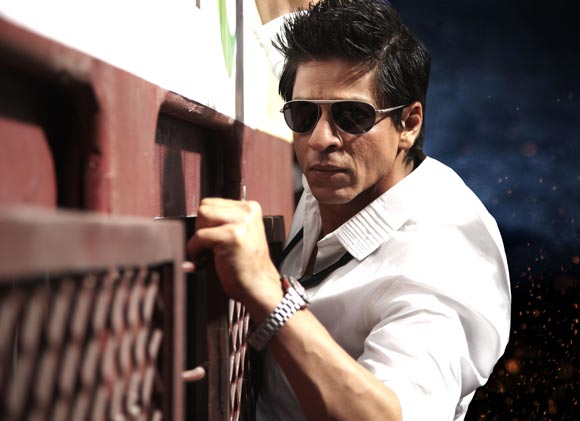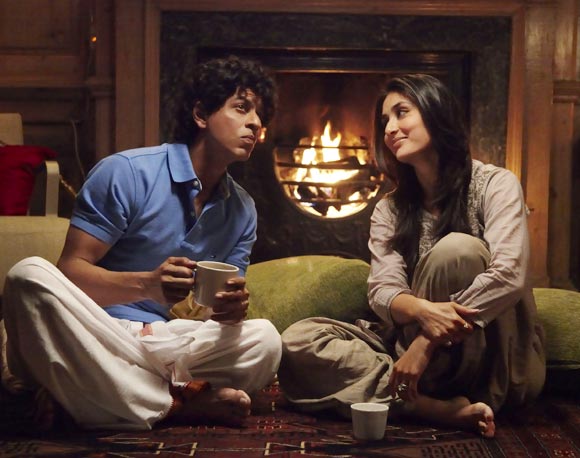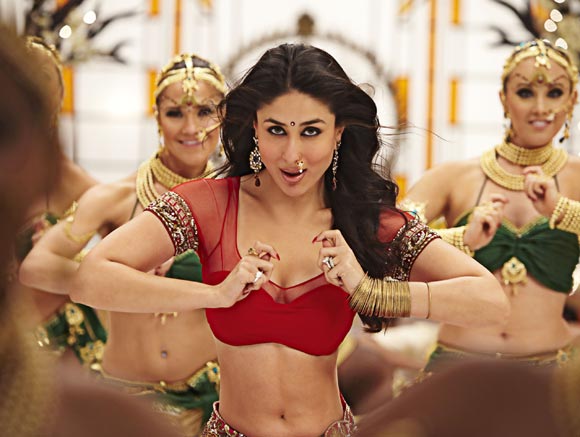 | « Back to article | Print this article |
Decoding Ra.One
Fantasy novelist Samit Basu encounters Ra.One. Exclusive to Rediff.com
I spent a lot of time this year wandering the wilderness of Bollywood trying to put together a film adaptation of my last novel, Turbulence, a superhero novel set in India and England.Whether it'll ever get made is a question that hasn't been answered as yet, but meetings with a few of Bollywood's movers and shakers have taught me many things about the way the Bollywood collective mind works when it comes to high-budget action blockbusters.
So here are some of the axioms, three Golden Rules based on which Bollywood blockbusters get made. They might help put your Ra.One experience in perspective.
Samit Basu is a writer of books, comics and one day, films you can all make fun of. Address all propositions and invective to @samitbasu on Twitter.
1. People are stupid
It's disturbing for anyone who plans to make a living as a writer to hear this, but an alarmingly large percentage of B-wood power-brokers said this with absolute confidence. I still believe this is not true, but hey. The 'audience' is seen largely as an amorphous, slack-jawed blob with the collective intelligence of a not-very-intelligent 11-year-old.
I suppose this holds true for Hollywood as well; it would explain many of their biggest commercial successes.
People will go and see any film that has been marketed with a great deal of pizzazz; it doesn't matter what's in the film as long as it's hardsold to them and stars someone they like.
There has to be at least one song that goes viral. The most worked-upon thing in the movie has to be the hero's abdomen. There have to be one or two 'dialogues' that people can repeat at each other ad nauseum.
Location is important.
It's distressingly cynical, but this rule works very often; just look at most of our recent Bollywood mega-hits and you'll see that this works.
It could be said in Ra.One's defence that it wasn't yet another cynical, brainless 'South masala' remake. But in between the splendidly-put-together action sequences, look at the utterly moronic jokes, the endlessly crass attempts at humour, the barrel-bottom-scraping homophobic/racist jibes, the numerous plot holes, the many logical inconsistencies, and you'll realise that this is a film that does not expect any degree of mental ability from its audience.
Like the aforementioned dim-witted 11-year-old, the audience must be told what to do. And what to like. If Ra.One works commercially -- and I hope it does, because I have a personal stake in wanting Bollywood to make more superhero films -- it will be yet another sad confirmation of this Bollywood principle.
Like they say, 'Film's purpose is to entertain. Don't overanalyse.'
2. People do not want to see anything new
'The Indian audience is not evolved enough for anything that Bollywood hasn't done before.'
This one was a particular shocker when I heard it the first time, because it goes against everything I've believed in eight years as a full-time writer.
But again, look around you -- television, movies, books -- and you'll see this is largely true.
As one Bollywood top maven told me with utter certainty, 'People want to sit in the hall, relax, enjoy themselves. Nobody wants to struggle with new ideas. It makes them angry.'
Fair enough -- if money wasn't a consideration, I'm sure everyone would be happy to be wildly experimental. But big movies mean big money, and big money means big risks, and if you don't give the audience what you already know it wants, you stand to lose everything.
The bigger the budget, the more the film must conform. None of this is new information.
The saddest part of the Ra.One experience is the growing realisation, as you watch the film, that the intentions of the team behind it were probably good when the whole epic project began. That at some level, it wanted to treat its audience as smart, and ready to see things it hadn't seen before.
There must have been, at some point, a genuine desire to push the envelope, to give quality-starved Indian audiences something new. And in the technical departments, Ra.One achieves that -- the VFX and sound are excellent, the crack international team behind the film has done its job well.
Yes, most of the action sequences and character designs are wildly derivative, but the same criticism could be applied to any number of successful Hollywood movies.
The problem with Ra.One is, though, that while it might have started off with the urge to push boundaries, it ended up being a confused mix of tried-and-tested and desperate-to-please. Worried that the film wasn't familiar enough, they stuck in gratuitous audience identification points -- Karva Chauth references, Ganesh idols -- and unnecessary celebrity cameos from Priyanka Chopra, Sanjay Dutt and the already superhuman Rajnikanth.
And the audience, already informed about these guest appearances by endless publicity, cheered dutifully -- and gave up any involvement they were feeling with the film's actual story.
It's easy enough to blame the writers for Ra.One's many flaws -- the most clear problem is the bad script. But while the writing was undeniably terrible, varying between cliche superhero/sentimental speeches and inane attempts at comedy/melodrama, let's not forget these writers were unlikely to have made any of the key decisions about the way this film was made -- there are probably lengthy debates about the marketability of every single line when the stakes are this high.
What we end up with, though, is a film that wants to be new and familiar at the same time, and does not know whether it wants to be compared with Iron Man or Dabangg.
It tries to be both, and fails at each; a film that was supposed to be ambitious and groundbreaking but at the very peak of its ambition, aspires to match a level of technical competence that Hollywood takes for granted.
What our esteemed Bollywood kings seem to be forgetting is that the application of these two axioms -- assuming the audience is sub-normal and hates change -- is exactly what has led to all of Bollywood's innumerable flops. If anyone knew what actually made films work, they would be bottling up that essence and selling it at malls.
3. The Hero is Everything
For Bollywood films above a certain scale, you can only raise money if one of the top five heroes of the moment agrees to do the film. And heroes are sensitive creatures who do not like sharing screen space, and like calling all the shots on their films. And physically being in most of the shots in their films.
This rarely yields good results in terms of quality, though it seems to work fine for the legions of love-crazed fans who flock into theatres and spew hate on the Internet in defence of their gods.
The chief problem with this axiom is that it imposes very dangerous constraints on films -- there can only be one central character, everyone else is window dressing.
In superhero-specific terms, it means we'll never have an X-Men/Avengers style multi-starrer superhero movie until this changes (On a personal note, every producer I met warned me that no hero would want to do an ensemble movie, and my script would have to be about one man only, regardless of the book it was based on).
Ra.One is unapologetically a Shah Rukh Khan vehicle, and it must be said the man tries everything -- he pulls off his most famous poses, tries out a range of facial contortions, hairstyles, costumes, accents, all in this vast, multi-crore attempt to please his son on and off screen.
But no amount of the Khan's much-vaunted histrionic abilities can hide the fact that the characters he's been given to play are flatter than his abs.
That said, Ra.One is not as one-actor-minded as, say, Ghajini, Singham or Bodyguard, and this is a good thing. Most of the praise that has come in for Ra.One can be reduced to 'Kareena and Arjun Rampal look amazing.' Excellent, but why bother with a story, then?
Surely it would be more economically viable to have people sit in theatres and look at slideshows of all these hot people. I might just have hit upon the Next Big Thing here.
An even bigger drawback of the hero-is-everything approach is that films which aim to be 'mass entertainers' usually feature heroes who are invincible even if they are flawed; Nietzschean Ubermenschen who stride through their stories casually beating up people while flooring heroines with their charm, supporting and entertaining their families, singing, dancing, nipple-baring and never, ever letting the whistles in the audience die out.
More superheroic than any superhero Hollywood's come up with yet, unbeatable musclemen, walking wish-fulfilment fantasies of millions of not-especially-Alpha Indian men.
Shah Rukh Khan does try to break this rule -- his real-world character is called a coward by his son, and we are repeatedly told that his video-game hero is weaker than the villain (though we see no real evidence of this.) Sadly, this is the biggest risk the film takes.
In a few weeks, we'll find out whether Ra.One is the biggest commercial success of all time or a huge flop. Like all Bollywood films of its scale, the essential quality of the film will be irrelevant either way, as frenzied fans and rival stars' fans battle it out across comment sections all over the Internet.
If Ra.One succeeds commercially, there will be a sudden explosion of superhero films; if not, no one will try one for the next few years (well, unless the sequel to the equally flawed Krrish is a box office smash).
Either way, given that Bollywood essentially has no idea about the basic tenets of superhero films, here are a few blindingly obvious guiding principles for those brave souls attempting the next one, whenever it happens. Click next to take a look.
A little internal logic would be nice
It feels sad to have to say this to people who are presumable a. professional writers and b. literate adults, but the fictional world you create must have rules, and these rules must be consistent.
In a superhero/scifi/fantasy story, you can stretch the laws of physics, but that's really all you can do. After that, you have to work hard, even harder than in a 'real-world' movie, to ensure that the rest of the world you create is logical, that everything else makes sense.
You can't just do whatever the hell you want with the plot, the characters, and the world your story is set in just because your heroes are more than human. If you have no internal logic system, you lose any member of the audience who is not a zombie.
The set-pieces in Ra.One are extravagant, executed by professionals who've done this sort of work before, and are something the rest of Bollywood should emulate -- though the hundreds of deaths that train action sequence would have caused leaves me in severe doubts as to the hero's competence, if not that of the VFX artists.
The rest of the film seems to have been put together by bumbling incompetents.
We need to know what the superhero/villain is
Are Ra.One and G.One humans? Robots? Or life-sized mannequins that come to life? And whatever the case, why do they have superpowers? I put software in my USB drive all the time; it hasn't started chasing me around the world and trying to kill me, at least not yet.
What are Ra.One and G.One and why do they have powers in the real world?
No one knows. No one seems to care. Even if one accepts that a piece of software escapes a video game and finds form in the real world, it is really rude to your audience to not even provide a semblance of a pseudo-scientific explanation as to how, unless you specifically mention that no one knows how it's possible, or explain it away by saying it's magic.
It's not enough to copy scenes from the Terminator movies; if you've seen them, you know there's a whole deal of elaborate explanation of how their bodies work the way they do.
G.One seems to be made of metal (hence, the horrible pierced groin in the metal detector scene) but surely someone at Dalip Tahil's video game company might have noticed that they'd made an incredibly complicated cyborg?
There's some brief introductory technobabble about how the gaming company creates tangible 3-D holograms, but then film ignores its own half-hearted attempts at explanation when the software, instead of just manifesting physically, proceeds to enter physical replicas of the video-game characters. Complete internal logic shutdown.
We really need to know what the superhero's powers are
At various points in the movie, G.One and Ra.One exhibit super-strength, super-speed, mind control, energy radiation, shape-shifting, self-healing and self-cloning abilities.
These powers crop up conveniently when the problem they're facing requires them, and disappear otherwise. Which indicates a. an utter contempt for the audience and b. really, really bad writers.
The villain is always stronger than the hero
Most superhero films have villains who are physically stronger than the hero; hence the hero has to struggle to overcome them.
This is a standard feature of a superhero film, not a breathtaking innovation the way Ra.One makes it out to be.
A little research helps
Ra.One's hero makes video games. His greatest achievement is a video game where you have to pretty much be a fully trained ninja/acrobat to defeat Level One.
I know Kinect controllers and the like require movement, but if you're planning a game where success is based on real-world acrobatics, you're looking at a seriously niche market.
Most video games involve sitting on a beanbag and pressing buttons. I suspect the Ra.One video game will require exactly that. If not, it is not going to be a commercial success.
While it is clear Team Ra.One knows nothing about superheroes, it would be nice if they knew anything about video games.
The villain has to be scary
What does our supervillain, Ra.One, want?
World domination?
Nuclear warfare?
The destruction of Facebook?
No, he wants to kill a small boy who was kicking him around in his videogame.
Granted the small boy was extremely annoying, and Ra.One had my sympathy for most of his few appearances, but you know what? This is not the kind of earth-shaking conflict situation you base a superhero movie on, unless it's a flat-out comedy or parody.
If you met Ra.One on the street, you could just get out of his way; he wouldn't bother you otherwise, unless you were foolish enough to buy what looked like a terrible game and take him on in it.
We also never really know what G.One wants, apart from protecting said annoying small boy from Ra.One. Once that's accomplished, it's difficult for us to care what happens to G.One, because, well, we don't know what he is!
Is he capable of turning human or otherwise giving Kareena Kapoor the loving she clearly needs?
Is he going to be locked in eternal combat with Ra.One in a video game that will presumably be cancelled by its makers since we know it's capable of unleashing real-world mass destruction?
Why should we care?
Reality and fiction are different things
Again, internal logic=good. You can have an interesting cross-film cameo from Cheeti the robot from Endhiran. You can have a celebrity cameo from Superstar Rajnikanth. You can't have both. Sorry. Not even for the reality-bending Rajnikanth.
In the end, how you feel about Ra.One depends entirely on what standards you're using to judge it. Does it measure up to the best of Hollywood, or to similar films made in China or Japan? No.
Is it better than the worst Hollywood superhero films? Certainly.
Is it a step forward for Bollywood? Absolutely.
But it's still unclear as to whether it's in the right direction.
